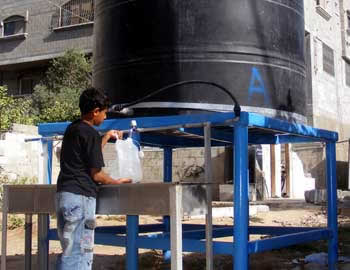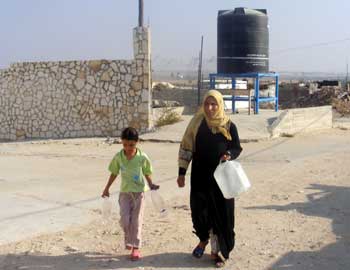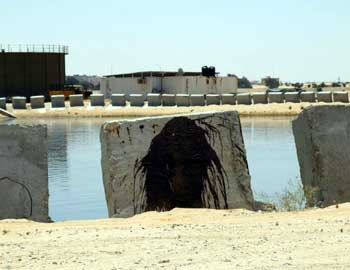AYMAN QUADER: THE HERO FROM MY PERSONAL PERSPECTIVE
by: Ayman T. Quader
What is a hero? From my perspective several thoughts emerge in my mind when I think of a hero, specifically in a very broad sense. The word hero applies dynamically to individuals in different contexts of culture, history, gender, etc. The term hero might generally be associated with that man who is brave, generous and courageous. Considering yourself a hero, you would intimately reflect your own identity, culture, conflict and history.
For me, it had been actually wonderful when I discovered that my personality is motivated toward many interests particularly in my career. I finished my studies from the Islamic University of Gaza and I was well-prepared to be a teacher of English language. Through my early life, people around me never stop telling me that I have got a smile face and always you enjoy being close with children. There is one prime characteristic I really admire about the life of the refugee camp that its small roads always crowed with young children where they have fun and enjoy their time in such dire environment. Accordingly, my attitudes had been changed from being teacher of English language for children into being very close to them through another dimension of work which the humanitarian aid and relief work.
Personally, it would be simple to identify the concept of hero according to my perception and my experience in Palestine. Having this course of childhood inside me, the hero is the Palestinian child who grows up and builds his life in the light of such dire conflict. This perspective is due to the fact that I lived in this situation of conflict my entire life as well as being close to children though my previous work. In this regard, I shift my thoughts dramatically to recognize the child’s Smile as heroic figure. This smile would cry lots of qualities and values specifically in the context of the Gaza Strip. My hero is a young Palestinian child who keeps a smile on his face and keeps aspiring of a better future despite living a life in struggle and conflict.
During the fifth model period, we took an exercise called Butoh Dance. In this exercise, my imagination and memory had been perfectly working and I went behind the dancing world. It enhances my bodily awareness not only for individuals but rather for social groups this happened through greatly activating my inner imagination. This took place when we were asked to play the role of being a tree then later on to consider myself, old woman, old man, and child. My flash memory easily helped me in order to recall those people where I lived part of my life with. The only image that recalled in my mind was a young child who is of 12 years. It was very much expressive for me as I spent fifteen minutes with in his world before I imagine myself a child. In this moment I had the feeling that I wanted to stay as long as I can with this child since this child is close to my heart. Subsequently, I realized that dancing and getting my body part moving negatively impacted the recalled image, and then I decided to still recalling the image while lying in the ground.
It’s hard to count the characteristics that constitute the child’s smile. Ambitious, amusing, patient, bearable, conscious, knowledgeable, would ensure the strength of this young child as a hero in the time of conflict and insecurity.
The Rights of Children in Gaza
The Palestinian child is directly affected by the scenes of incursion, blood and war. The child is not given the basic childhood rights. It is even hard for her/him to find a space for fun, and also to get her/him physiological needs satisfied. The child retains memories of all means of death that his/her family passed through during the time of instability and warfare caused by the Israeli regular militant activities in his/her area.
Children around the world all share something in common in terms of love needed, compassion and smile. The Palestinian Gazan child has experienced an ongoing siege of unprecedented severity, including various blockages of fuel and electricity provisions, as well as all other energy resources. Israel has also imposed a strict closure on all the Gaza Strip border crossings, preventing movement of civilians, including patients seeking medical care.
Young heroes
In my following examples I would like to illustrate my definition of hero in clearer manner. There are many examples of children that inspired me while I was in my home. In this example, I will prove how the smile and the joy of children in Gaza are really heroic figures.
To start with, I remember my seven-year old sister’s smile Raghed enjoying her romantic candle light while studying her science lesson. The candle lighting at her table was not due to a special occasion. In fact, candles have become a necessity for Raghed and all children in Gaza due to the regular cut of electricity. Her smile still waves within my imaginary how she created sort of fund out of this exceptional hard situation she passed.
To move from Raghed to another aspiring childhood example named Loa’I Suboh. After the recent 23-day of war (Dec 2008 – Jan 2009) on the Gaza Strip, I started reporting some of the tragic stories directly from the mouths of children. One month after the attack, I met Loa’i Suboh, a ten-year old child who has lost his eyes in the attacks. He was injured by an Israeli air raid targeting his family in north of the Gaza Strip. Loa’i was wounded when he left the United Nations Relief and Works Agency (UNRWA) School with his family, as they were taking shelter on the premises. They wanted to get back to their home to fetch some personal belonging things like food and blankets. Loa’i was left bleeding for an hour and half and no one was able to have access to him and save him because of the heavy of the Israeli shelling at that time. One year after these sad events, Loa’i assured me that his blindness will never obstruct his future to be a good business man. Loa’i is an active and intelligent boy. His steadfastness and determination to complete his studies and accomplish his goals are in my opinion truly heroic, even if, sadly, his case is far from being unique.
According to data from the Palestinian Center for Human Rights (PCHR), 313 children under the age of 18 were killed in 23 days of war on the Strip (Palestinian Center for Human Rights, 2009:13). A great number of children has been killed or injured as a result of the Israeli offensive on the Gaza Strip. The majority were killed as a result of Israeli violations of International Humanitarian Law[1] (IHL), such as willful killing, violations of the principle of distinction, indiscriminate and disproportionate attacks. After years of occupation and conflict children already stressed were profoundly traumatized. The significant number of killing of children or leaving them with a more or less severe handicap, has increased the cases of children suffering from Post Traumatic Stress Disorder (PTSD) while there is no child who didn’t suffer a major trauma: from destruction of his home to loss of a parent, a sibling, from destruction of his school, playground, to the loss of a friend, a neighbor. They still dream and hope for peace and having space for entertaining.
I remember a Day of Action for children organized in one of the Refugee camps in the centre of the Gaza strip named (Al-Maghazi refugee camp). The event was called “Quest for Smile”. Through this after-school event, I saw the steadfastness of the children’s smiles, their smiles full of innocence. They eagerly assembled during this event and shared moments of joy and friendship. The event was organized in a local park fifty meters away from a demolished building. During the recent Israeli assault over the Gaza Strip, three children living in Al-Maghazi refugees camp were killed, and over 30 were critically wounded. Those children had been suffering from the ongoing insecurity of war and blockade over them. They were extremely cheerful during this event. “No words can express the joy experienced by these children during the event”, said one audience member, noting how the children couldn’t stop clapping and dancing with the costumed performers. The young children enjoyed several activities and performances, including dancing, group games, a trivia contest, and others, as well as spending some leisurely time outside with friends. It is really inspiring to see the bad psychological state of these children, and see how they bear such difficult circumstances and still have fun.
Through my experience as a humanitarian aid worker in Gaza, I realized how the children are affected by the consequences of the conflict and the conditions on the ground. I witnessed their struggle and how they fight to keep a smile on their faces. They play on the rubble of their homes and keep smiling. This is my hero personal perspective that embodied with children smile. Now I will explore etymological meaning of hero in Arabic since the Arabic language is a bit difficult in exploring the etymological words.










 Interview with Haidar Eid
Interview with Haidar Eid



